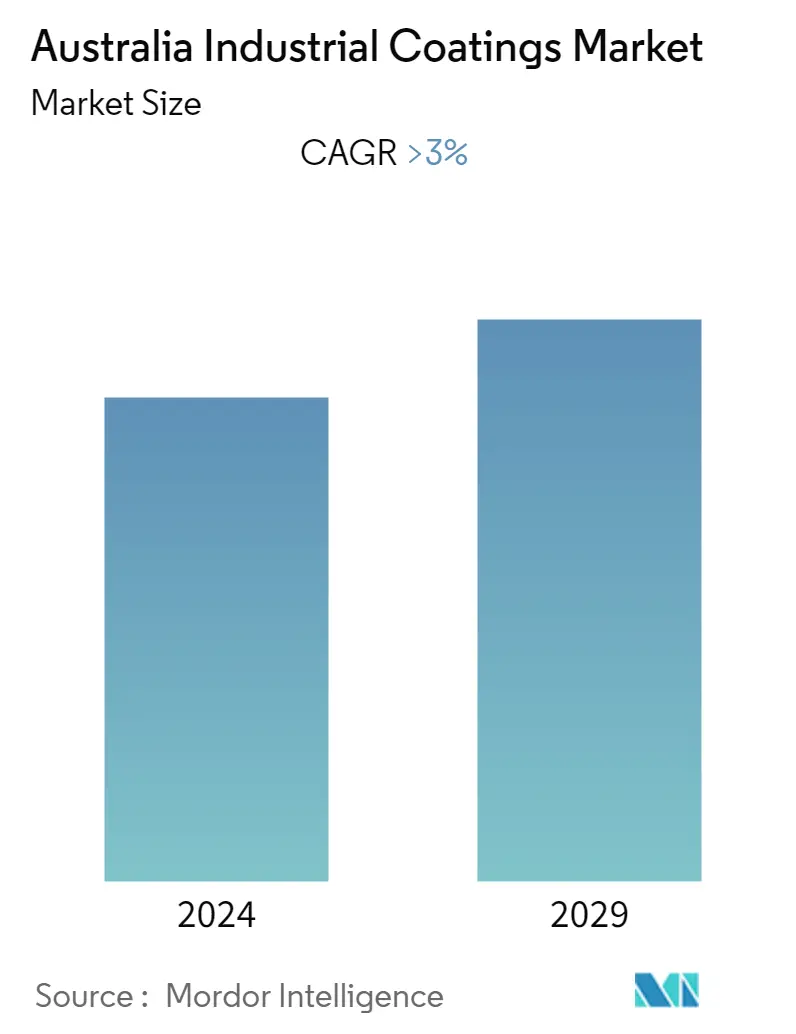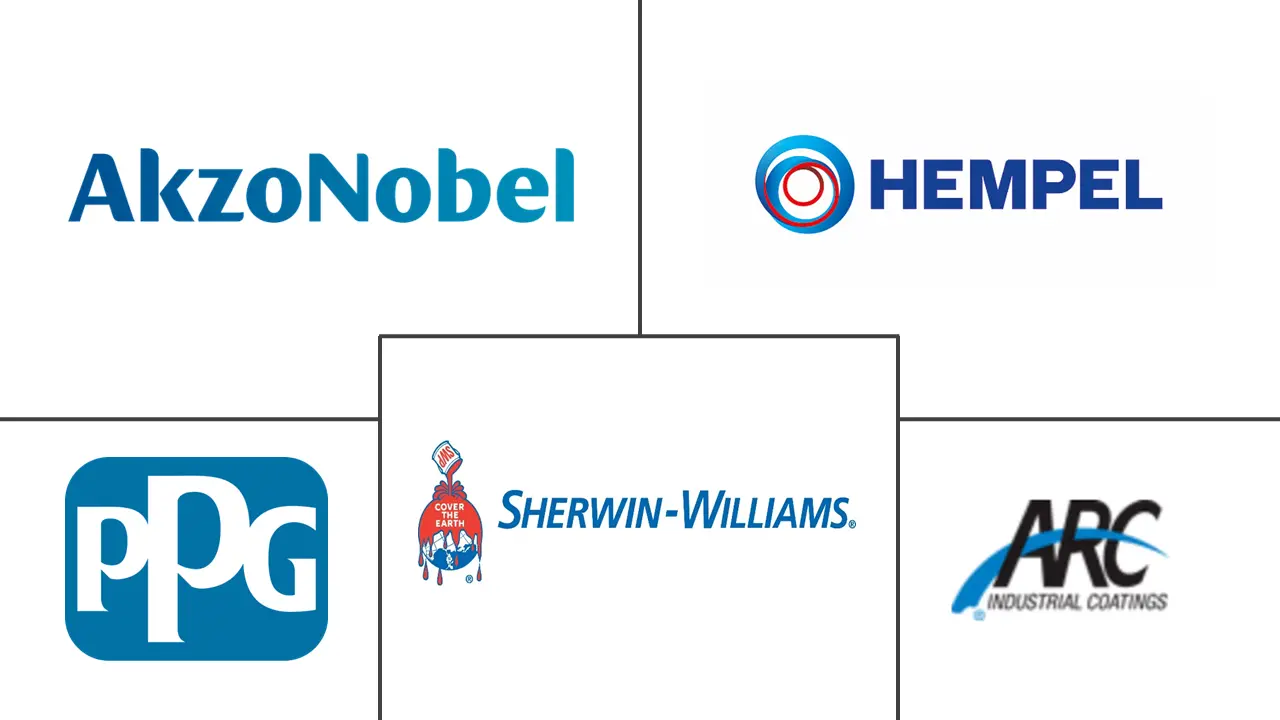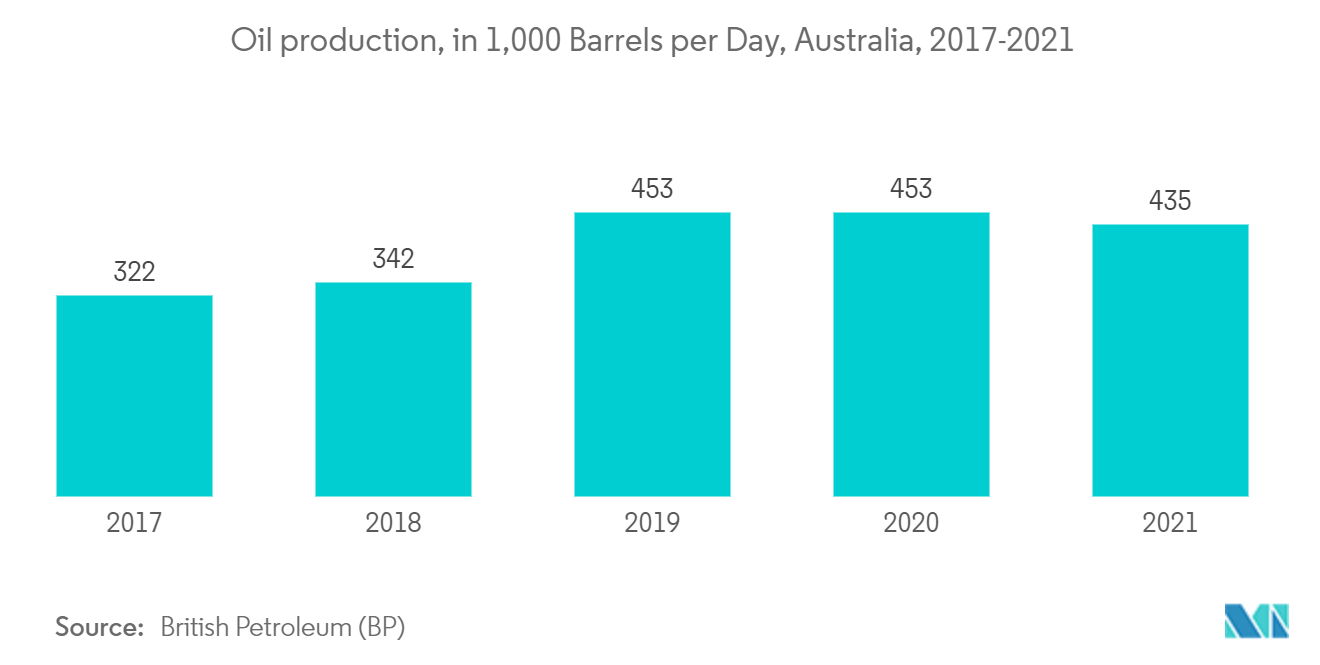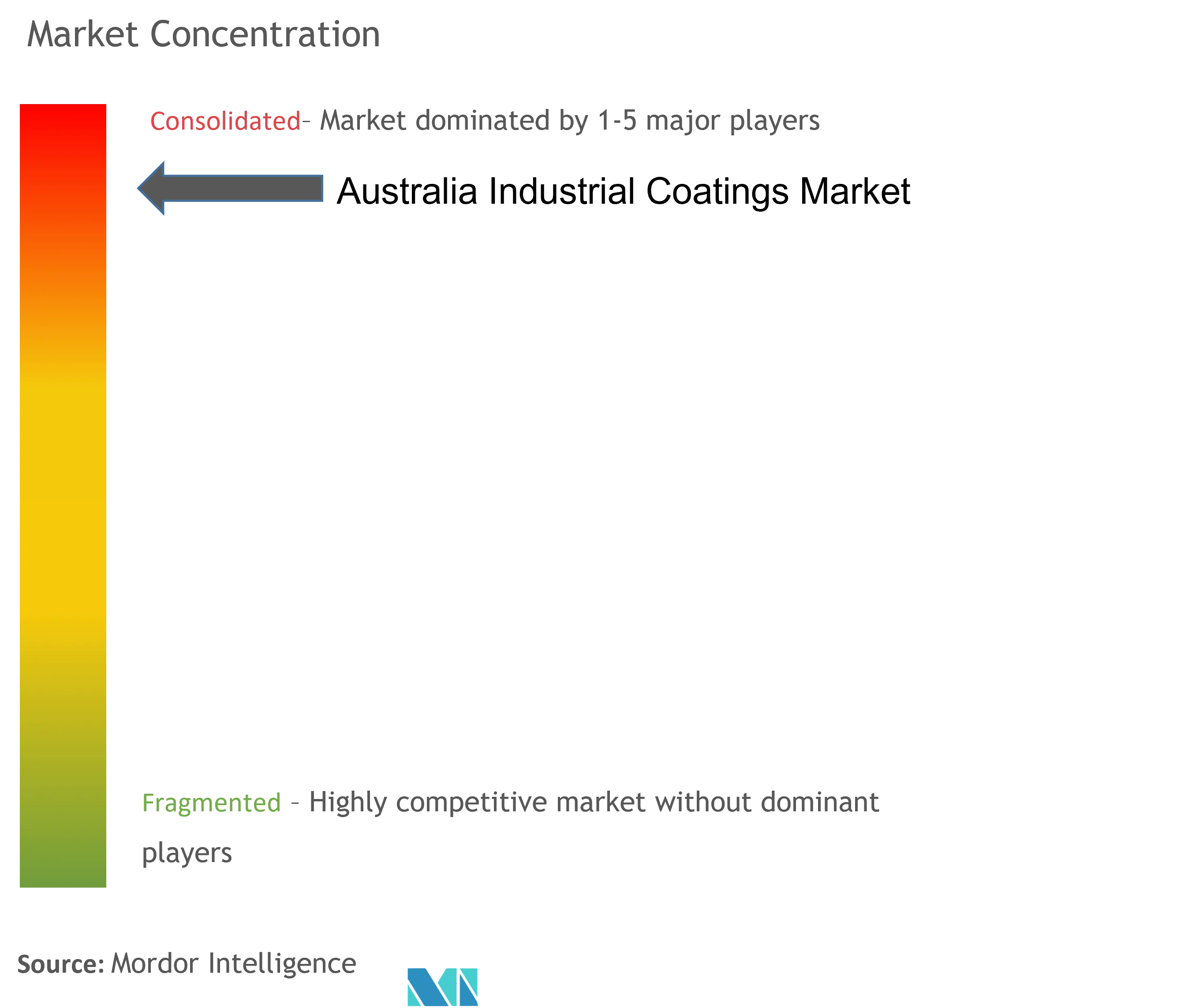Australia Industrial Coatings Market Size

| Study Period | 2019 - 2029 |
| Base Year For Estimation | 2023 |
| Forecast Data Period | 2024 - 2029 |
| Historical Data Period | 2019 - 2022 |
| CAGR | 3.00 % |
| Market Concentration | High |
Major Players
*Disclaimer: Major Players sorted in no particular order |
Australia Industrial Coatings Market Analysis
The industrial coatings market in Australia is expected to register a CAGR of over 3% during the forecast period.
The COVID-19 pandemic negatively impacted the industrial coatings market in Australia since the major end-user industries were forced to close due to manpower shortages. Currently, it is anticipated that the market has returned to pre-pandemic levels.
- Increasing demand for protective coatings and growing usage of corrosion coatings are expected to drive the industrial coatings market's growth in Australia.
- The harmful environmental impact of solvent-borne coatings is the major factor hindering the growth of the target market.
- Increasing demand for highly durable products is anticipated to create new opportunities in the near future.
Australia Industrial Coatings Market Trends
This section covers the major market trends shaping the Australia Industrial Coatings Market according to our research experts:
Oil and Gas Segment to Dominate the Market
- In the oil and gas industry, protective coatings are used in pipelines and equipment of both the downstream and midstream segments to transfer oil and gas due to their anti-corrosion, heat-resistant, abrasion-resistant, and fire-resistant properties.
- Protective coatings provide a viable solution to many corrosion challenges in the oil and gas industry, including drilling, wellhead, and sub-sea equipment. Millions of paint are used to protect these assets.
- Downstream oil and gas equipment must work well under harsh temperatures, pressure, and agitation conditions. They also need to have enhanced corrosion and chemical attack resistance. Industrial coatings protect against abrasion, corrosion, pressure and temperature extremes, and potent chemical agents.
- In 2021, over 461,000 barrels per day of petroleum and other liquids were produced in Australia, of which crude oil made up 26%, condensates 46%, natural gas liquids 24%, and other drinks and refining gains made up 4%. This study indicates the large consumption of industrial coatings in Australia.
- According to British Petroleum, approximately 435 thousand barrels of oil a day were produced in Australia in 2021, compared to 453 thousand barrels of oil a day in 2020.
- According to sweet crude traders and refinery sources, Australia's crude oil exports increased 19% year over year in October 2021 due to significant shipments of sweet crude to Singapore and condensate sales to South Korea. This expansion indicates the future opportunity for the Australian industrial coatings market in the oil and gas sector.
- Hence, increasing demand for industrial coatings in the oil and gas segment is likely to dominate the market within the country.

Growing Demand for Water-borne Coatings Technology
- Waterborne technology is a type of surface treatment in which water is used as a solvent to dissolve resin to create coatings or paints. Water-borne coatings are widely used technology due to their non-reactive and environmentally friendly nature.
- Solvent-borne coatings use organic solvent to disperse the resin, which is costly and nature compared to water-borne coatings. Hence, water-borne coatings are gradually replacing solvent-borne coatings in the automotive and construction sectors.
- Nowadays, water-borne coatings are widely used in the construction sector for floor paints, walls, roofs, metal bodies, swimming pools, and many other applications.
- Water-borne technology is widely used in the automotive industry. For instance, according to the Organisation Internationale Des Constructeurs Automobiles (OICA), Australia produced 14% more vehicles in 2021 than the previous year, which is expected to continue. Thus, the automotive sector is expected to have a high demand for water-borne technology in the future within the country.
- Australia is a major liquefied natural gas (LNG) exporter and a major petroleum consumer, consuming 1,018 thousand barrels per day, resulting in high pipeline and equipment demand within the country. Water-borne coatings are mostly used as a protective coating in the petroleum industry due to their fast drying and environmentally friendly properties, which increases the demand for water-borne industrial coatings in the country.
- Hence, with increasing demand for water-borne coatings technology, the Australian industrial coating market is projected to increase over the forecast period.

Australia Industrial Coatings Industry Overview
The industrial coatings market in Australia is consolidated in nature. Some of the major players in the market include PPG Industries, AkzoNobel N.V., Arc Industrial Coatings, The Sherwin-Williams Company, and Hempel A/S, among others.
Australia Industrial Coatings Market Leaders
-
PPG Industries
-
AkzoNobel N.V.
-
Arc Industrial Coatings
-
The Sherwin-Williams Company
-
Hempel A/S
*Disclaimer: Major Players sorted in no particular order

Australia Industrial Coatings Market News
- June 2022: PPG introduced the PPG ENVIROCRONTM LUM coating, the industry's first commercial retroreflective powder coating. The patent-pending layer is designed to aid vision at night and in low-light conditions.
- February 2021: Hempel announced a purchase agreement with Wattyl (Australia's leading manufacturer of decorative and protective coatings). The acquisition of Wattyl will strengthen the company's position as the leading digital platform in the Austrian industrial coatings market.
Australia Industrial Coatings Market Report - Table of Contents
1. INTRODUCTION
- 1.1 Study Assumptions
- 1.2 Scope of the Study
2. RESEARCH METHODOLOGY
3. EXECUTIVE SUMMARY
4. MARKET DYNAMICS
-
4.1 Drivers
- 4.1.1 Increasing Demand for Protective Coatings
- 4.1.2 Increasing Usage of Corrosion Coatings
-
4.2 Restraints
- 4.2.1 Harmful Environmental Impact of Solvent-borne Coatings
- 4.2.2 Other Restraints
- 4.3 Industry Value Chain Analysis
-
4.4 Porter's Five Forces Analysis
- 4.4.1 Bargaining Power of Suppliers
- 4.4.2 Bargaining Power of Consumers
- 4.4.3 Threat of New Entrants
- 4.4.4 Threat of Substitute Products and Services
- 4.4.5 Degree of Competition
5. MARKET SEGMENTATION (Market Size in Value)
-
5.1 Resin Type
- 5.1.1 Epoxy
- 5.1.2 Polyurethane
- 5.1.3 Acrylic
- 5.1.4 Polyester
- 5.1.5 Other Resin Types
-
5.2 Technology
- 5.2.1 Water-borne Coatings
- 5.2.2 Solvent-borne Coatings
- 5.2.3 Powder
- 5.2.4 Other Technologies
-
5.3 End-user Industry
- 5.3.1 General Industrial
- 5.3.2 Protective Coatings
- 5.3.2.1 Oil and Gas
- 5.3.2.2 Power
- 5.3.2.3 Infrastructure
- 5.3.2.4 Other End-user Industries
6. COMPETITIVE LANDSCAPE
- 6.1 Mergers and Acquisitions, Joint Ventures, Collaborations, and Agreements
- 6.2 Market Share (%) **/ Ranking Analysis
- 6.3 Strategies Adopted by Leading Players
-
6.4 Company Profiles
- 6.4.1 AkzoNobel N.V.
- 6.4.2 Axalta Coating Systems
- 6.4.3 BASF SE
- 6.4.4 Beckers Group
- 6.4.5 Chugoku Marine Paints, Ltd
- 6.4.6 Dulux Protective Coatings
- 6.4.7 Hempel A/S
- 6.4.8 Jotun
- 6.4.9 PPG Industries
- 6.4.10 RPM International, Inc.
- 6.4.11 Sika AG
- 6.4.12 The Sherwin-Williams Company
- 6.4.13 Wacker Chemie AG
- *List Not Exhaustive
7. MARKET OPPORTUNITIES AND FUTURE TRENDS
- 7.1 Increasing Demand for High Durable Products
Australia Industrial Coatings Industry Segmentation
Industrial coatings are polymer compounds primarily utilized to fulfill industrial design criteria such as non-stick performance, corrosion resistance, and chemical protection on the coated surface. Australia's industrial coatings market is segmented by resin type, technology, and end-user industry. By resin type, the market is segmented into epoxy, polyurethane, acrylic, polyester, and other resin types. By technology, the market is segmented into water-borne coatings, solvent-borne coatings, powder, and other technologies. By end-user industry, the market is segmented into general industrial and protective coatings. For each segment, the market sizing and forecasts have been done on the basis of value (USD Million).
| Resin Type | Epoxy | |
| Polyurethane | ||
| Acrylic | ||
| Polyester | ||
| Other Resin Types | ||
| Technology | Water-borne Coatings | |
| Solvent-borne Coatings | ||
| Powder | ||
| Other Technologies | ||
| End-user Industry | General Industrial | |
| Protective Coatings | Oil and Gas | |
| Power | ||
| Infrastructure | ||
| Other End-user Industries |
Australia Industrial Coatings Market Research FAQs
What is the current Australia Industrial Coatings Market size?
The Australia Industrial Coatings Market is projected to register a CAGR of greater than 3% during the forecast period (2024-2029)
Who are the key players in Australia Industrial Coatings Market?
PPG Industries , AkzoNobel N.V., Arc Industrial Coatings , The Sherwin-Williams Company and Hempel A/S are the major companies operating in the Australia Industrial Coatings Market.
What years does this Australia Industrial Coatings Market cover?
The report covers the Australia Industrial Coatings Market historical market size for years: 2019, 2020, 2021, 2022 and 2023. The report also forecasts the Australia Industrial Coatings Market size for years: 2024, 2025, 2026, 2027, 2028 and 2029.
Australia Industrial Coatings Industry Report
Statistics for the 2024 Australia Industrial Coatings market share, size and revenue growth rate, created by Mordor Intelligence™ Industry Reports. Australia Industrial Coatings analysis includes a market forecast outlook to 2029 and historical overview. Get a sample of this industry analysis as a free report PDF download.



